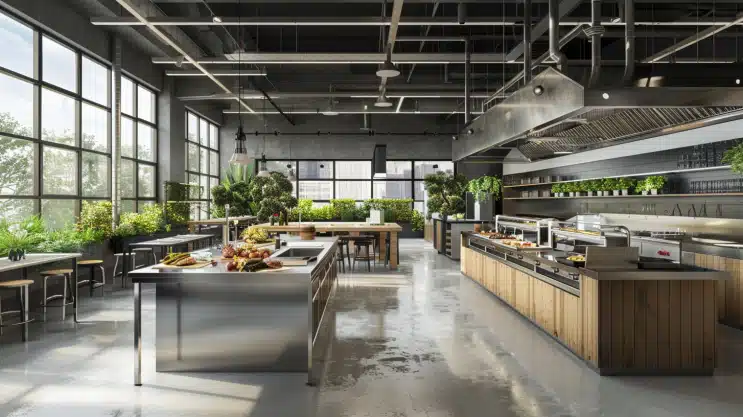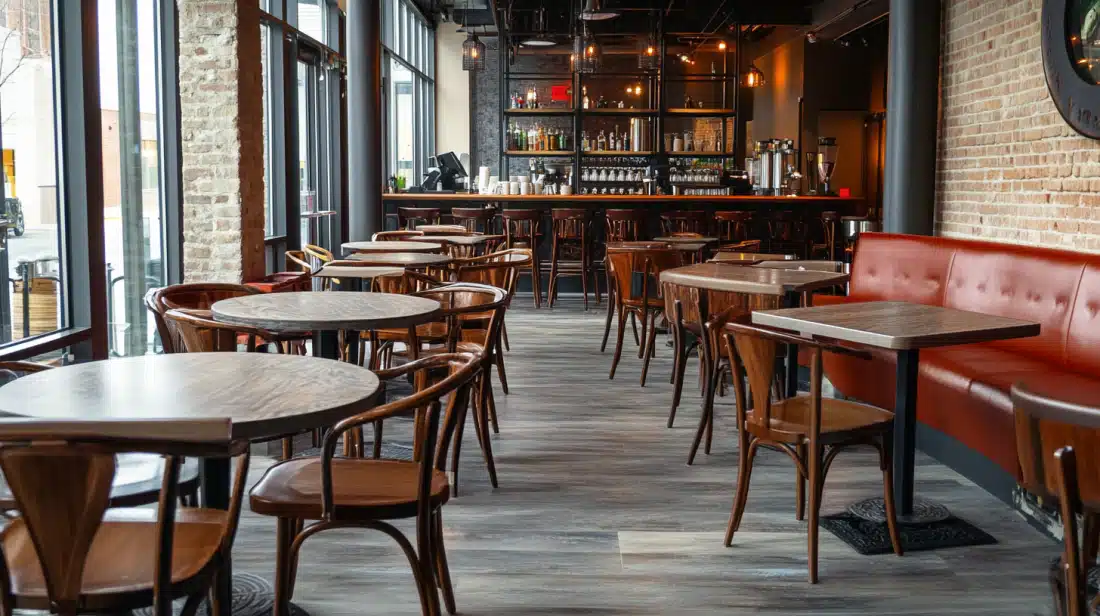As the restaurant sector evolves and grows so does the furniture that occupies these dynamic spaces. The role of commercial-grade restaurant furniture has evolved beyond simply offering a place to sit and dine.
Today’s furniture designs are increasingly geared at improving the dining experience through smart design and technological integration. This transition reflects broader developments in consumer expectations and operational efficiency, straining the limits of restaurant furniture capabilities.
With technological improvements and a rising emphasis on sustainability, restaurants are adopting useful and innovative furniture solutions. In this article, we will look at developing trends in restaurant furniture, the impact of smart designs, and how technology is influencing the future of dining spaces.
Emerging Trends in Restaurant Furniture

Restaurant furniture design has evolved significantly from the days of conventional hardwood tables and chairs. Over time, the industry has shifted significantly toward multipurpose and modular items. These developments focus not only on beauty but also on functionality and adaptability.
Multifunctional furniture can serve a variety of purposes, such as seating that turns into storage or tables that alter in height to meet changing needs throughout the day. Modular designs allow for quick reconfiguration, making it easier for restaurants to change their layouts to new events or changing client demands.
Sustainability has also been an important consideration in furniture design. With increased awareness of environmental issues, more eateries are choosing eco-friendly materials.
Bamboo, reclaimed wood, other repurposed metals, and sustainable fabrics are now popular options, lowering the environmental effect of furniture manufacturing. This trend is fueled by both customer demand for greener alternatives and the industry’s effort to lower its carbon footprint.
Trends in furniture are also heavily influenced by consumer tastes. Modern diners are looking for more than simply good food; they want an unforgettable experience.
This desire for a one-of-a-kind and individualized eating experience is inspiring furniture designs that represent the restaurant’s personality and brand. Customizable and themed furniture that complements the restaurant’s concept can improve the overall atmosphere and add to an unforgettable eating experience.
Smart Designs in Restaurant Furniture
Smart furniture marks a new frontier in restaurant design. These components include innovative features that go beyond traditional functionality.
For example, some smart tables include built-in charging connections for electronic devices, allowing diners to charge their devices as they eat. Others provide changeable components, such as height and angle modifications, to meet a variety of demands and tastes.
Integrating technology into furniture improves both convenience and consumer happiness. Consider a table that can automatically adjust its illumination according to the time of day, or a chair that recalls a customer’s preferred seating position. Such inventions have the potential to improve the dining experience by personalizing it.
Smart furniture also provides significant operational efficiency. Features such as automatic reservation systems and furniture that track usage trends can assist restaurant managers in optimizing their space and improving service. Smart furniture, for example, may collect data on peak dining times and customer preferences, allowing for more accurate staff scheduling and inventory management.
Technology Integration in Commercial-Grade Furniture

Technological breakthroughs are changing the way restaurant furniture is designed and used. The integration of internet functionality into furniture provides increased connectivity and control.
IoT-enabled furniture may communicate with other devices, such as lighting and climate control systems, to create a unified and adaptive dining experience. This link can also improve operational efficiency by delivering real-time information about furniture usage and repair requirements.
Data analytics is critical to improving furniture location and consumption. Restaurants may make better furniture layouts and design selections by studying data on client behavior and seating preferences. This data-driven strategy optimizes space use and enhances the overall dining experience.
Material and manufacturing process innovations are also influencing restaurant furniture design. New materials, such as sophisticated composites and durable textiles, are being employed to design furniture that is both fashionable and long-lasting. Similarly, new manufacturing techniques provide increased customization and efficiency in production, allowing restaurants to receive distinctive and high-quality furniture options.
Enhancing Customer Comfort with Technology
Many restaurants prioritize customer comfort, and technology helps them achieve it. Smart seating solutions are ergonomically engineered, with customizable features to accommodate a variety of body shapes and preferences. These changes can improve comfort and guarantee that each guest has a positive eating experience.
Adjustable and ergonomic characteristics are especially significant in restaurants that serve a diverse clientele. Adjustable-height tables, for example, can accommodate guests with unique needs, and ergonomic chairs can provide extra support for extended periods of sitting. This kind of attention to detail can greatly increase client satisfaction.
Technology also helps to create a comfortable dining environment. Smart lighting systems may vary brightness levels based on the time of day or atmosphere desired, while temperature control systems keep visitors comfortable throughout their meals. These technologies improve the whole dining experience and make the restaurant atmosphere more pleasant.
Operational Efficiency through Smart Furniture
Smart furniture has numerous advantages for restaurant operations, beginning with easier maintenance and cleaning. Furniture with easy-to-clean surfaces or self-cleaning capabilities can help save time and effort on maintenance. This efficiency not only reduces labor costs but also assures that the restaurant maintains a high level of cleanliness.
Another advantage of smart furniture is that it has automated mechanisms for tracking inventory and usage. Restaurants can use sensors and tracking technology to monitor furniture conditions and usage patterns in real time. This information aids in inventory management and ensures that furniture is maintained or replaced as necessary.
Investing in smart furniture yields considerable cost savings. While the initial expenditure may be larger, the long-term benefits from lower maintenance, increased efficiency, and improved operational performance can more than offset the costs. Smart furniture can improve resource management and reduce waste, which contributes to cost savings.
Future Directions and Predictions
The future of smart furniture technology looks promising, with countless potential innovations on the way. Advances in materials science, robotics, and artificial intelligence are expected to generate additional advances in restaurant furniture design. These technologies may allow for more sophisticated and adaptive furniture solutions.
Future trends in commercial-grade restaurant furniture include further incorporation of smart technologies and a sustained emphasis on sustainability.
As consumer expectations shift, restaurants must stay ahead of the curve by incorporating new technologies and design trends. This might include introducing more interactive and immersive components into furniture design.
New technology will change the future of restaurant surroundings in exciting ways. From augmented reality to advanced automation, these innovations will change the way restaurants run and how clients dine. Staying educated about these developments will be critical for restaurant owners seeking to remain competitive.
To Summarize: Embracing the Future of Restaurant Furniture
When we look ahead, it’s evident that the function of commercial-grade restaurant furniture is changing dramatically. The incorporation of smart designs and technology is more than simply a trend; it represents a substantial shift that promises to improve both consumer experiences and operational efficiency. By embracing these advancements, restaurants may create more dynamic, pleasant, and environmentally friendly dining spaces.
Staying ahead in furniture design and technology is critical for a restaurant business. As new technologies and design trends develop, restaurants that are ready to experiment and adapt will be better positioned to provide extraordinary dining experiences. Embracing the future of restaurant furniture entails investing in solutions that improve both functionality and enjoyment, paving the way for a new era of culinary excellence.

